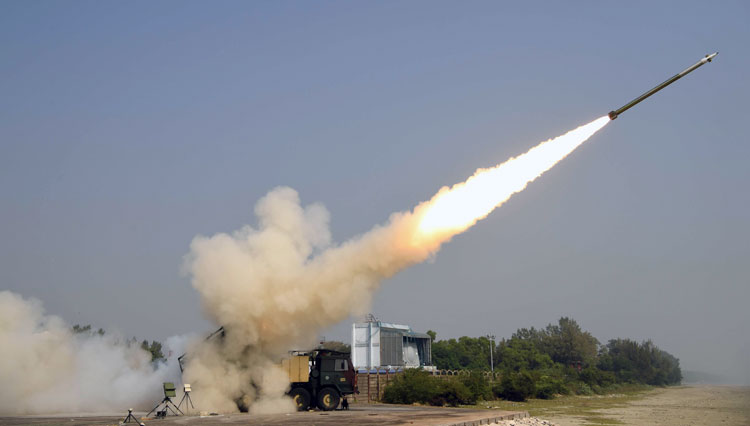INDIAN ARMED FORCES CHIEFS ON OUR RELENTLESS AND FOCUSED PUBLISHING EFFORTS

The insightful articles, inspiring narrations and analytical perspectives presented by the Editorial Team, establish an alluring connect with the reader. My compliments and best wishes to SP Guide Publications.

"Over the past 60 years, the growth of SP Guide Publications has mirrored the rising stature of Indian Navy. Its well-researched and informative magazines on Defence and Aerospace sector have served to shape an educated opinion of our military personnel, policy makers and the public alike. I wish SP's Publication team continued success, fair winds and following seas in all future endeavour!"

Since, its inception in 1964, SP Guide Publications has consistently demonstrated commitment to high-quality journalism in the aerospace and defence sectors, earning a well-deserved reputation as Asia's largest media house in this domain. I wish SP Guide Publications continued success in its pursuit of excellence.
- Appointments Committee of Cabinet approves one-month extension in service of Chief of the Army Staff
- Prime Minister witnesses 'Bharat Shakti' – a Tri-Services Firing and Manoeuvre Exercise in Pokhran, Rajasthan
- Interim Defence Budget 2024-25 — An Analysis
- Union Defence budget 2024
- Indian Army: In quest of greater firepower and policy recommendations for gaps
- Indian Army Annual Press Conference 2024
- Tata Boeing Aerospace Delivers 250 AH-64 Apache Fuselages, Manufactured in India
Upgraded Pinaka Rocket System
 |
The Author is Former Director General of Information Systems and A Special Forces Veteran, Indian Army |

On December 19-20, 2019, the upgraded version of Pinaka guided rocket system was successfully test-fired to a range of 90 km from the Integrated Test Range, Chandipur, off the Odisha coast. The missile system has been jointly developed by various Defence Research and Development Organisation (DRDO) laboratories viz Armament Research and Development Establishment (ARDE), Research Centre Imarat (RCI), Defence Research and Development Laboratory (DRDL), Proof & Experimental Establishment (PXE) and High Energy Materials Research Laboratory (HEMRL). The mission achieved all the objectives including enhancing the range, accuracy and sub-system functionality. The flight was tracked by multiple range systems viz telemetry, radars, electro-optical targeting system (EOTS), etc, which confirmed the textbook flight performance.
The Pinaka Mk-II rocket is modified as a missile by integrating with the navigation, control and guidance system to improve the end accuracy and enhance the range. The navigation system of the missile is also aided by the Indian Regional Navigation Satellite System (IRNSS) termed NAVIC. The upgraded Pinaka Mark-II missile system is capable of striking into an enemy territory up to a range of 90 km with high precision, compared to Pinaka Mark-I which has a maximum range of 40 km. The Pinaka project was sanctioned by the Ministry of Defence (MoD) in 1983 and development began in December 1986, with a sanctioned budget of 26.47 crore, with the development phase to be completed in December 1992. Pinaka is to replace the Russian BM-21 Grad launchers operated by the Army. Pinaka is a complete MBRL system, each Pinaka battery consists of: six launcher vehicles, each with 12 rockets; six loader-replenishment vehicles; three replenishment vehicles; two Command Post vehicles (one stand by) with a Fire Control computer, and the DIGICORA MET radar. A battery of six launchers can neutralise an area of 1,000 m × 800 m. All of the 72 rockets can be fired in 44 seconds. Each launcher can fire in a different direction too. The system has the flexibility to fire all the rockets in one go or only a few.
The launcher can operate in autonomous mode, stand-alone mode, remote mode or manual mode. Pinaka MBRL System was tested during the Kargil Conflict and the first Pinaka regiment was raised in February 2000. The Army had reportedly placed intent for Pinaka Weapon System worth 1,300 crore. On October 29, 2015, the Defence Acquisition Council (DAC) chaired by the Defence Minister, cleared purchase of two more Pinaka regiments at a cost of 3,300 crore. On March 18, 2016, the Cabinet Committee on Security (CCS) cleared the purchase of two additional Pinaka regiments. On March 7, 2016, the CCS cleared an order of additional six Pinaka Regiments to augment the four regiments cleared earlier.
The Army is networking all its artillery units together with the Artillery Command & Control System (ACCS) – the first information system fielded. The Pinaka units are also linked to the Surveillance & Target Acquisition (SATA) Units which have improved over the years with induction of Searcher and Heron UAVs as well as Battle Field Surveillance Radars (BFSRs), both indigenous and Israeli, and the Long-Range Reconnaissance and Observation System (LORROS) imported ex Israel. The Army presently has two operational Pinaka regiments. Plans are to operate 10 regiments by 2022 and increase this number to 22 within in the next 10 years as the older Grad-21 MLRS regiments are retired. The Pinaka Mark-II, also called 'Guided Pinaka', was successfully tested at the Chandipur ITR in January 2013, December 20, 2013, May 20–23, 2016. On January 12, 2017 and January 24, 2017 two successful tests was conducted with range of 65 km and 75 km respectively. This was followed by two rounds fired successfully on May 30, 2019. Another round of tests was conducted successfully on March 11, 2019. An extended range version was tested for a range up to 90 km on December 19, 2019 followed by another test on December 20. The Pinaka is in the process of further improvement.
The Israel Military Industries (IMI) is teamed up with DRDO to implement its Trajectory Correction System (TCS) on the Pinaka, for further improvement of its CEP, trials of which are ongoing. The rockets can also be guided by GPS to improve their accuracy. Additionally, DRDO's ARDE and partner organisations are launching a project to develop a long-range MRL, similar to the 'Smerch'; a rocket for the Pinaka MBRL that can carry a 250 kg payload to a distance of 120 km. The Pinaka Mark-1 had successfully pulverised Pakistani positions on hilltops during the Kargil Conflict. The upgraded Pinaka Mark-II is a significant development with Pakistan intent on continued hostilities in J&K. Pakistan indulged in 2,317 ceasefire violations during 2019 till October 10 compared to 1,829 ceasefire violations throughout 2018.
China, which backs Pakistan in all anti-India activities including hostilities in J&K, is overhauling Pakistan army's artillery firepower by supplying 236 x SH-15 howitzer guns. China's Northern Industries Corporation (NORINCO) has received the first installment of payment of $20 million in accordance the deal signed on June 27, 2019 worth $512 million. The SH-15 trials were carried out near Karachi earlier this year. The SH-15 system uses a 6A-6 wheeled Shaanxi truck chassis for carrying a 155mm howitzer mounted at the rear of the truck. The truck also has two spades connected to the howitzer at the rear for stabilizing the system. The SH-15 will equip 13th Artillery Regiment of Pakistani army. NORINCO claims that the maximum range of the SH-15 is 53 km with a rocket-assisted artillery projectile, similar to the eight-year-old SH-1 system. The Pinaka Mark-II with 90 km range provides greater punch to Indian Artillery. The rocket under development carrying 250 kg payload to a distance of 120 km will boost it further.





